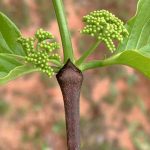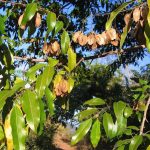TREE LIFE
February 1998
The annual subs are due again. After deliberating over a murky crystal ball the Committee has reluctantly decided that the new subs must be $60. Please use the attached invoice when paying and indicate if your address has changed.
Stop Press! Anthon Ellert, Chairman of the Bulawayo Branch is planning a trip to the botanically exciting Buchwa Mountain in August. This entails advance planning so if you think you would like to be on that trip please contact Anthon in Bulawayo at home as soon as possible so that an assessment of the size of the group can be made and plans set in motion.
MASHONALAND CALENDAR
Saturday 31st January. Mark’s Walk is moved back a week because of the Nyanga trip. This month Mark wants to revisit an interesting spot in Borrowdale, where previously during the month of September we were introduced to terrestrial orchids. That species i.e. Eulophia may be over but perhaps there will be some others. It is also a good spot for grasses.
Tuesday 3rd February. Botanic Garden Walk. This month Tom continues the series on some of the lowveld trees. We will meet Tom in the car park at 4.45 for 5.00 p.m. and there will be a guard for the cars.
Sunday 15th February. Meeting time is 9.30 a.m.
Saturday 28th February. Mark’s Botanic Walk will be to St. George’s College where Fr. H Ross has planted and nurtured his special plants over the years. We will meet in the car park at the school at 2.30.
Tuesday 3rd March. Botanic Garden Walk.
MATABELELAND CALENDAR.
January 29th to 1st February. Visit to Sentinel Ranch near Beitbridge – a long weekend or longer. A family house is available for our use with 8 beds and mattresses and a garden to camp in. Cost $50 per night per person. Please make contact with Jonathan or Anthon for further details.
The Sentinel trip replaces the regular Bulawayo outing, so our visit to Chipangali has been rescheduled to 1st March.
Wednesday 4th February.
On the first Wednesday of each month an episode of the wonderful video The Private Life of Plants will be shown at Girls’ College at 7.30 for 8 p.m. The episodes have enchanting titles such as: Travelling; Growing; Flowering; Social Struggle; Living together; and Surviving.
Sunday March 1st. Visit to Chipangali where we have been invited to assist in the development of an indigenous tree woodlot.
TALKING OF TREES
May I add a few more items to the note by J H Wilson, which appeared in Tree Life No 215 (January 1998)?
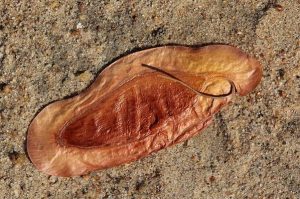
Newtonia hildebrandtii. Photo: Bart Wursten. Source: Flora of Zimbabwe
Right alongside the grove of Newtonia hildebrandtii upstream of Nyahungwe camp on the Lundi River there is an outstanding specimen of wild ebony, Diospyros mespiliformis, possibly the largest of its species in Zimbabwe. In June 1986 it had a height of 32 metres and a bole diameter of more than 2.7 metres (measured at breast height – 1.3 metres – above ground).
At Chamuluvati camp there is a very large specimen of Khaya anthotheca, red mahogany, which would not feel out of place in Chirinda Forest. In June 1986 this tree was 46 metres tall, with a bole diameter at breast height of more than 2.4 metres. This could be the tallest tree in the whole of Gonarezhou National Park, or in the whole of the south-eastern lowveld for that matter.
At Mabalauta (Buffalo Bend) on the Mwenezi River there is an outstanding specimen of Cordyla africana, wild mango, with a height of 32 metres, a diameter at breast height of more than 2.2 metres, and a crown spread of 57 metres (June 1986). Its crown spread had been measured some time earlier at 60 metres, but the very severe drought years of the early and middle 1980s had almost certainly caused the crown to shrink a little.
Just outside Gonarezhou, on the opposite side of the Lundi from Chipinda Pools and slightly upstream is another huge Cordyla africana, somewhat shorter and smaller in diameter than the one at Buffalo Bend, but with a crown spread nearly as great at 55 metres (August 1988).
-Lyn Mullin.
BOTANIC GARDEN WALK: 6 JANUARY 1998
The subject for today’s walk was lowveld trees and we began in the strange world of the desert house. From the driest part of Zimbabwe, which is the Tuli Circle/Sentinel Ranch area in the south of the country, came a number of unusual plants, which Tom collected in October 1997 in temperatures of 42°C.
One small tree, which is fairly common in that area and which we saw on the Tree Society visit last year, was the extraordinary squat Sesamothamnus lugardii, with its greenish to brownish peeling trunk. The family of Sesamothamnus is Pedaliaceae and nearby was a little herbaceous plant from the same family, namely Pterodiscus. This has, as the name suggests, flattened (i.e. disk-shaped) fruits, which have marked wings at the margin. They also have extra-flora nectaries near the base of the petioles.
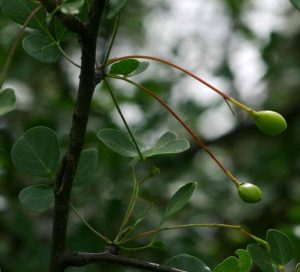
Commiphora tenuipetiolata. Photo: Bart Wursten. Source: Flora of Zimbabwe
Later in the Gardens we were shown Commiphora tenuipetiolata, with its delicate 3-foliolate leaflets. This is another plant from the dry south. Its distribution in southern Africa includes South Africa, Botswana and extends across to Namibia.
Another plant I associate with Tuli is the very beautiful Catophractes alexandri. At Tuli in March this was producing its large flowers, many of which were white but also included shades of pink. The leaves are simple (unusual for Bignoniacea)e, opposite and greyish-white and the plant is spiny.
Another SE lowveld species, which has something of the appearance of Sesamothamnus, is Sterculia rogersii. As Tom mentioned, this is a case of parallel evolution, where plants from unrelated families (Pedaliaceae and Sterculiaceae in this case) develop similar forms in response to a similar environment. The Sterculia has a grotesque swollen trunk and rather small lobed leaves.
Three species of Cordia were seen. Cordia belongs to the family Boraginaceae, which although predominantly herbaceous has a woody section, represented by Cordia and Ehretia in Zimbabwe. Both Cordia ovalis and Cordia goetzei have similar fluted greyish-blue trunks, which are an extraordinary sight. The species of Cordia were revised in Flora Zambesiaca and it is not 100% clear what ovalis has become, but it seems that it should now be called Cordia monoica.
Cordia goetzei has also been split into two, namely Cordia goetzei and Cordia mukuensis. Both have the fluted trunks and both do seem rather similar.
Finally, new to me, even though it occurs around Harare, for example at Chedgelow Farm, was Cordia sinensis, which was both flowering and fruiting. No fluted trunk in this case.
A large number of other species were seen (too many to mention here). Once again, we must thank Tom for his time and patience.
-Mark Hyde
NYARUPINDA CATCHMENT Dec 1997
Introduction.
1997 was a nomadic year, April and May beside the Richmond River in New South Wales, then July and August in England. Ample time to make notes and drawings of dendro’ interests for these pages throughout 1998.
Homecoming
August 23 1997 was the first dawn at home, the sounds: a friendly, welcome, from a laughing dove set us up for the busy day, a gabbled song of the yellow-eyed canary and toppies calling to each other in the savannah woodland garden atop a quartz outcrop, which overlooks tree species typical of heavier dolerite soil.
Fabaceae Pods.
Pods galore! Were we the only people who developed a wobbly walk, wonky ankles in Brachystegia country? Pods round, pods coiled (in the dry, pods flat in the wet), pods winged, straight, papery or leathery, woody and ridged, fleshy, splitting or indehiscent or breaking into 1-seeded portions – all these have amazed us with their size and profusion.
Ten Years Ago
On January 26 we left the Dutch gabled house at Katawa and moved to the tall thatched house we designed, that was built by Snoden and his gang on the boundary of Sipolilo Estates and Chepstow. Reference to the Raffingora and Mutorashanga 1: 50,000 maps show the South Eastern aspect, the view across the Nyarupinda river towards the kopjies named Mariwanu, Jese, Bere, Canon, Lion and many others reaching almost to the Great Dyke on the skyline. Beyond this range at night we see the glow of Harare more than 100km distant.
Recently Ian and Margaret Barron who live among these kopjes mentioned that they were farming Brachystegia, so many seeds have germinated everywhere – they would grow into an extensive forest if there were regular reliable rainfall.
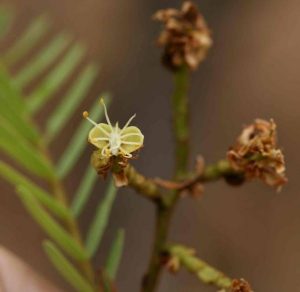
Brachystegia boehmii. Photo: Petra Ballings. Source: Flora of Zimbabwe.
At Tinto garden we have noticed 2 seedlings of Brachystegia boehmii having pure white adult leaves – what will happen to these plants? Any one else seen the like?
In the early letters to the Tree Society I voiced a problem of the identity of a strange humming after dark around 7 p.m. and in the morning before the dawn chorus during the rainy season. The thatched gables of the house collected and amplified these sounds – as compared with listening out of doors.
A.J.L. Lambiris provides the answer in his book Frogs of Zimbabwe page 53. Bufo gutturalis – the Greater Cross-marked Toad, whose call is a deep vibrant croak repeated every three or four seconds. Frequently 2 or more males will call antiphonally, one answering the other to produce a sustained series of sounds. The pamphlet on wood carving postage stamps mentions the Guttural Toad. The chorus came from the upper reaches of the Dedi dam on the boundary of Nyarupinda Extension farm.
Regards to all, especially those who visited Tinto in February 1988 when after lunch it rained but we had a quiz ready for that eventuality.
-Benedicta Graves
STRANGE PROFILES
Nature is at the same time architect, civil engineer, and designer builder. And as plants have evolved, they have recognised all the rules of hydraulics and of building mechanics. The result is that species exist that are equipped to survive just about anywhere on earth.
People in hot countries, for example, have long known that the sphere, with the smallest possible surface area in proportion to its mass, is the best shape to reduce the rate at which heat is absorbed and water evaporated, and so many buildings in such countries have domed roofs. The same principle is at work in nature so that many desert plants are globular. In this way, half the plant is always in the shade.
Nature also pre-empted the tinted window of office blocks. The African desert plant Fenestraria grows mostly below ground with only a window of translucent cells at the surface. Some of the cells filter out dangerous ultraviolet light, while others diffuse the bright desert light to manageable levels for photosynthesis – by which green plants turn light into energy.
Cactuses, by contrast, stand above ground, growing to tremendous sizes. To store the water they need to survive in hot deserts, they must have a strong cage-like structure, with a pliable, pleated outer skin to contain and support the weight of the water. The reinforced-concrete structure of modern buildings is based on exactly the same principle.
The dwarf tree Welwitschia mirabilis has one of the most unusual designs in the plant world. With an iron-hard stem rarely more than knee-high to a human, but up to 5 ft (1.5m) in diameter, the tree has two long leaves that sprout from the base at a rate of 6 in (15 cm) a year. They can be up to 30 ft. (9m) long, writhing across the ground, torn by winds and fraying at the ends, so that in time they form a tangled mass that might well cover an area of about 200 ft2 (20m2). Up to 9ft (2.7m) of the stem, meanwhile, lie under¬ground, and the taproot reach still deeper.
A young Welwitschia may be a few hundred years old; an old one may date from the time of Christ, 2000 years ago. Welwitschia is a species that also has separate male and female plants, bearing cones similar to flowers. It is adapted to thrive in one of the world’s most hostile regions, the Namib Desert of Namibia, where the average rainfall is less than ½ in (1.3cm) a year and five years may pass without rain. It never grows more than 62 miles (100km) from the Atlantic Ocean, and has evolved a survival strategy quite unlike that of most desert plants, which tend to rely for their water on elaborate root systems.
In addition to what it can get from its long taproot, the plant’s pores absorb water from the heavy morning fogs that cling to the Namibian coast and are often blown inland. When the sun disperses the fog, the pores close to retain the water.
The seeds have to wait for the desert’s occasional rainfall before they can germinate. Here, too, Welwitschia is specialised for arid conditions. In most plants the ‘cotyledons’ – the first leaves of the embryo seed – are discarded after a few days. Welwitschia has cotyledons that store enough food reserves to continue feeding the young plant for up to five years, until the next rainfall arrives.
This extract is taken from Nature’s Masterpieces – Published by Readers’ Digest and acknowledged with thanks.
-Mark Hyde
ANDY MACNAUGHTAN CHAIRMAN


